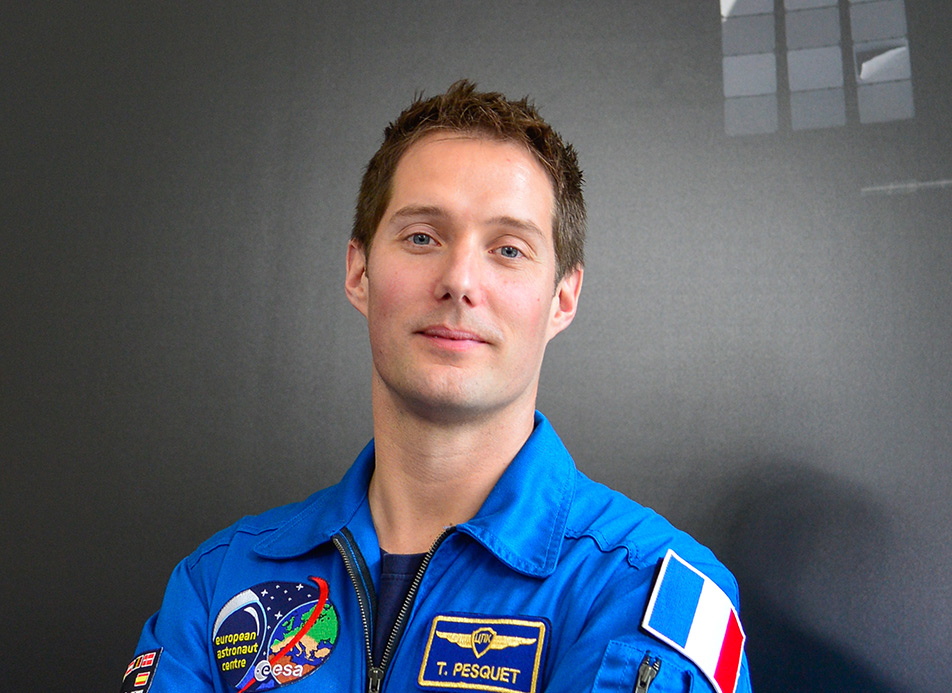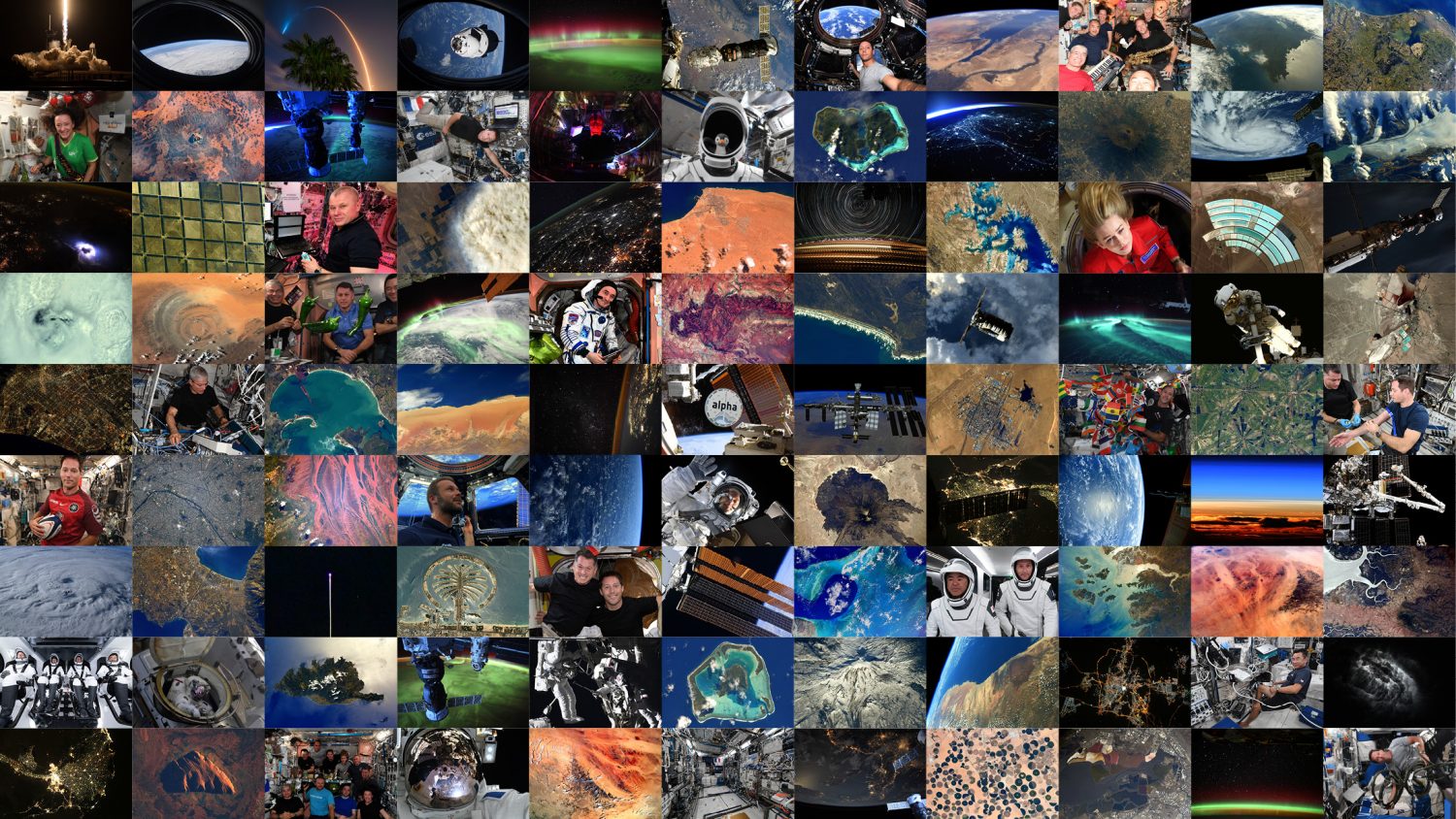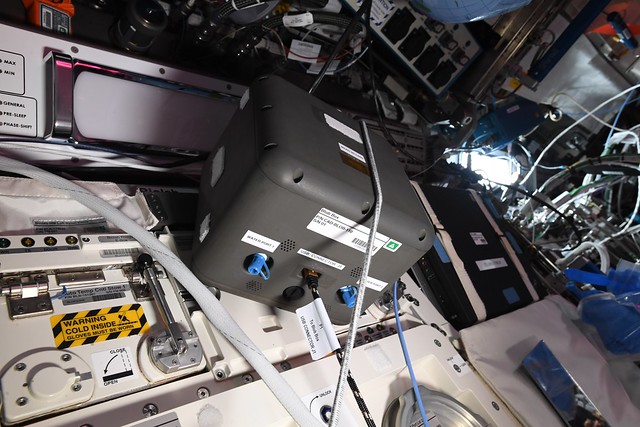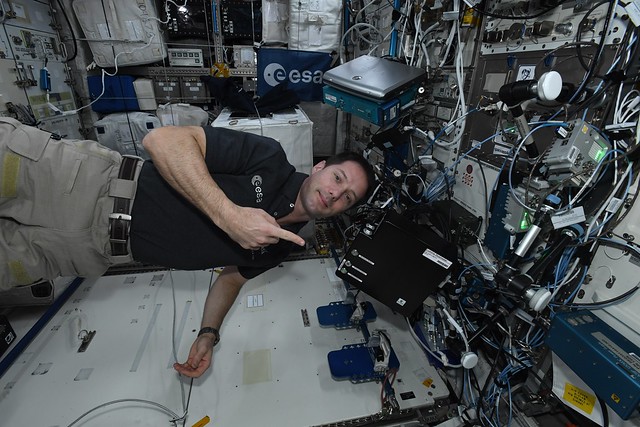On Thomas Pesquet’s 100th day in space for his Alpha mission we did an overview of all his activities on the International Space Station, 100 days later, let’s look at what he has been up to up there on the second half of his mission.
Many of the experiments are repetitions from the first 100 days, as is one of the Space Station’s unique advantages: offering researchers long-term continuous weightless to run experiments and chart changes in the human body over many months.
Let’s break it up into themes again:
Science
Biology and biotechnology
Cell Science-04
Thomas worked on the Cell Science-04 experiment that arrived by Cargo Dragon CRS-22 trasnport spacecraft. The investigation is looking at a species of tardigrades, also known as water bears. These microscopic animals are extreme survivors and can withstand huge temperature differences, even having spent months unprotected outside the Space Station in a previous ESA–Roscosmos study! The Cell Science-04 experiment is characterising the species’ genes to discover their secrets to survival.
Oral Biofilms
Thomas continued work on the Oral Biofilms experiment to help researchers investigate bacteria and how they form biofilms, in space. The experiment takes place in the Station’s glovebox to keep the fluids contained and not escaping into the environment, even though the bacteria grow naturally in our mouths. The research is interested in finding out more about the biofilms that grow on our tongues or teeth. Will they still grow as well in space, and can we find ways to stop them?
The Grip and Grasp experiments
Thomas continued to have sessions with the Grip and Grasp experiments. Wearing a virtual reality headset and grasping objects while motion trackers record his arm movement and speed.
Grip and Grasp are two neuroscience experiments looking into how our brain takes microgravity into account when grabbing or manipulating an object.
Cardinal muscle
Another Glovebox experiment, Thomas worked on NASA’s Cardinal Muscle investigation to test whether engineered tissues cultured in space could provide a model for studying muscle loss and assessing medicine before clinical trials.
Muscle tone with Myotones
Astronauts experience muscle weakening in space and when they return to living with the effects of Earth’s gravity after a mission. The Myotones experiment monitors the muscle tone, stiffness and elasticity of the astronauts’ muscles with a non-invasive, portable device on the Space Station.
Thomas completed more science sessions together with NASA astronaut Megan MacArthur. A total of 12 astronauts will be taking part in it in the hope of identifying the best countermeasures and improving the lives of many people affected by strained muscles. The device is already used on Earth as an alternative to muscle biopsies.
Anti-Atrophy
Thomas worked on preparing samples and installing them for the Anti-Atrophy investigation. Muscle wasting affects both astronauts living in microgravity and people on Earth, particularly the elderly. This research examines how biomaterials that can either slow down muscle atrophy or accelerate muscle growth could be used to supplement exercise as a countermeasure in space. Obviously the findings could advance development of pharmaceuticals to prevent muscle atrophy for people on Earth.
Dosis-3D
Shortly before leaving the Space Station Thomas replaced the Dosis radiometers that are dotted around the interior. They are monitoring the radiation received at different places to get an overview of where there is more radiation to help the design of future spacecraft and protect astronauts from radiation.
Technology development and demonstration
Pilote
Thomas and Megan continued running sessions of the Pilote experiment in the European Columbus laboratory proposed by France’s space agency CNES. They virtually guided a drone through an obstacle course and grappled a spacecraft with a robotic arm.
The Pilote experiment evaluates a new way of providing tactile and visual feedback to astronauts when operating robots. A virtual reality headset and a haptic joystick recreate the feeling of pressure and touch when the astronauts fly a robotic arm.
The results from Pilote will help improve the astronauts’ robotic skills not only on the Space Station, but also for operating rovers on the surface of the Moon and Mars.
Immersive Exercise
Astronauts exercise two hours a day to compensate for the loss of bone and muscle mass from living in weightlessness. The daily workout can quickly become repetitive in the closed and unchanging environment, leading to lack of motivation. The Immersive Exercise experiment aims to break the monotony with virtual reality. Coupled with the Space Station’s exercise bike, an astronaut can pedal in space while riding through Earth landscapes. Videos filmed in 360° on Earth are played back on the headset, with the speed changing depending on how fast the astronaut pedals. A number of scenes have been captured, including one trip around Paris and its monuments at Thomas’s request. Already in use in some terrestrial fitness centres, the Immersive Exercise equipment could evolve to include gradient difficulties to recreate mountain roads. The Immersive Exercise technology should keep astronauts motivated on the International Space Station and improve their performance – an important aspect to consider on longer missions to the Moon and Mars.
Physical science
Fluidics
The Fluidics experiment looks at a phenomenon called ‘sloshing’ – how liquids move inside closed spaces. The goal is to help industry design better satellite fuel-systems to increase their life and make them less expensive.
A second part of the experiment looks at surface turbulence in liquids. On Earth, gravity and surface tension influence how a force dissipates in waves or ripples. By conducting Fluidics in space, scientists could observe how surface forces behave without gravity – removing one factor from the equation simplifies understanding the phenomenon.
The experiment consisted of three small transparent spheres with a centrifuge to move the liquids inside. One sphere used for the wave turbulence experiment held distilled coloured-water, the other two spheres used for the sloshing experiments used a special liquid developed with low viscosity and little surface tension.
Aside from gaining a better understanding of the movement of fluids this experiment could help us understand our oceans and on a larger scale our planet’s climate as a whole.
Ring shear drop
Thomas worked on a run of NASA’s Ring Sheared Drop investigation, a device that keeps liquid contained using surface tension rather than a solid container – only easily possible in weightlessness. The device traps a drop of liquid between two rings and rotates one while keeping the other stationary to create shear flow, or a difference in velocity between liquid layers. It allows researchers to study protein aggregations called amyloid fibrils, which form a waxy plaque in the brain and could be a factor in development of some neurological diseases.
Declic
The DEvice for the study of Critical LIquids and Crystallization, DECLIC, is a facility to study supercritical fluids and how materials solidify. Super critical fluids are neither gas nor fluid, but in the state between the two. This state is easier to stabilise without gravity interfering and so researchers hope to understand the phenomenon better by observing it inside DECLIC. Thomas worked on facility during his Alpha mission, but the facility is a frequent flyer and was on the Space Station from 2009 to 2014 before being sent back for maintenance.
Soft Matter Dynamics
Thomas worked with the Soft Matter Dynamics facility that is looking at how granules of different densities and how they interact with each other. These dynamics are of interest for industrial operations such as the processing of grain and plastic granules. As the granules fall to the bottom of a container very quickly on Earth, their dynamics can only be investigated under microgravity conditions.
InSPACE-4
NASA’s “Investigating the Structure of Paramagnetic Aggregates from Colloidal Emulsions-4” or InSPACE-4 experiment looks at liquids of colloids and how nanoparticles floating inside could be manipulated by magnets to make new structures – and new super materials with better qualities.
Human research
Generic health, sample taking, urine, blood and more
Regularly astronauts take samples for researchers and flight surgeons on Earth. Not the best part of the job, and Thomas didn’t escape this task either. Often done in the morning before breakfast the samples are stored in the Station’s freezers.
Thomas, like the other astronauts also took ultrasounds of his eyes, scanned his veins for thrombosis and assessed his hearing as well as running a tonometry session to measure intraocular eye pressure. Regular check-ups in space.
TIME
This experiment uses virtual reality to chart whether our perception of time changes when living on the International Space Station.
Since perceptions of time and space are believed to share the same neural processes, and research on depth perception in weightlessness has shown that astronauts often underestimate distance, scientists speculate that, for astronauts, time also flies in space.
ESA’s Time experiment on the International Space Station investigates the claim that time subjectively speeds up in microgravity.
Dreams
The CNES Dreams experiment is putting Thomas’ under the magnifying glass. The experiment uses a novel sleep headband to study how sleep is influenced by living in weightlessness and isolation. Using small ECG sensors, this biomedical device will collect neuroscientific data that will help prepare for long missions to the Moon and Mars.
Vascular Echo
Thomas helped with a session of the Canadian Space Agency’s Vascular Echo experiment using ultrasound to monitor blood vessels. As humans get older on Earth, arteries stiffen and this causes an increase in blood pressure (hypertension) and elevates the risk for cardiovascular disease. Astronauts returning from the International Space Station have shown to have stiffer arteries than when they went into space. The results from studying these changes could provide insight into potential countermeasures to help maintain astronaut health, and quality of life for everyone.
Educational and cultural activities
Thomas worked on the educational computers AstroPi to run student code for this year’s competition. They can be moved around the Station and students upload new software for the little computers to run making use of their many sensors and cameras.
EVA Z-cam
The EVA Z-cam is a 360 degree camera mounted on the Station’s robotic arm that filmed Thomas and JAXA astronaut Aki Hoshide during their spacewalk together. The camera promises to offer a immersive experience of working in space. Thomas helped to set it up and get it ready before being sent outside to be picked up and mounted to the Station’s robotic arm.
Blob
Thomas took care of the Blob slime mould as an educational experiment on the Space Station to see how the slime mould’s behaviour is affected by microgravity. Students in France replicated the experiment in their classrooms, comparing their results to a timelapse video from space, to see differences in the Blob’s speed, shape and growth.
Eklosion
In addition to tending to the small crop of hatch chile peppers that were grown to test gardening, a new European investigation, Eklosion, studies the psychological benefits of gardening and observing nature off our Earth.
Techno Box
Techno box is an educational project to visualise sound waves in three dimension. Chladni forms are a phenomena that occur when sounds vibrate small particles into geometric forms. On Earth they stay in two dimensions usually on a vibrating plate of metal, but in space without the constraints of gravity, three dimensional forms should be possible. This CNES educational experiment is also called TetrISS and is aimed to inspire schoolchildren in France to take up maths subjects at school.
Earth and space science
Radiation – LIDAL
Thomas returned the radiation monitor LIDAL to its original position after running the GRIP experiments. LIDAL is an addition to the existing ALTEA facility, upgrading ALTEA’s ability to take measurements that can be converted by dedicated software in real-time to become a dosimetric risk meter aboard the ISS.
Lumina
This CNES experiment in collaboration with CERN, iXBlue and LabHC, consists of kms o fibre optic cables to see if they are a viable technology to monitor ionising radiation received in the Space Station. Inside The box of cables is both light-weight and takes up little space so could be a valuable tool for farther exploration of our Solar System.
Spacecraft movement
Many spacecraft came and went during the second part of the Alpha mission, including a spacecraft relocation to another port.
In the cargo department, Thomas and NASA astronaut Megan McArthur grappled the Cygnus NG-16 cargo spacecraft on 12 August with the Space Station’s robotic arm and brought it to berth with the Unity module.
The automated Russian Progress spacecraft MS-17 arrived at the Space Station on 2 July 2021 at the Poisk module, but it was then moved to the latest addition to the Space Station, to redock with the Nauka module on 22 October. This was done to make space for the docking of Soyuz MS-19 with Anton Shkaplerov, Yulia Peresild and Klim Shipenko onboard. They arrived on 5 October 2021. Yulia and Klim only stayed on the Station for 9 days, leaving on a different spacecraft, the Soyuz MS-18 with commander Oleg Novitsky on 17 October. The Soyuz MS-18 itself had already relocated on 28 September, also moving to the Nauka module in preparation for the new arrivals.
Dragon cargo mission CRS-24 arrived at the Space Station on 30 August staying docked with the outpost for a month. It brought over 2000 kg of cargo to the Space Station.
A final cargo spacecraft for this mission when Thomas was on board, Progress MS-18, arrived on 30 October 2021, bringing thousands of kilos of new supplies to the outpost. All of the cargo spacecraft required lengthy preparation, unpacking and setting up the new experiments and equipment.
Spacewalks
Episode 4
Thomas returned outside of the Station for a fourth spacewalk as part of mission Alpha. He accompanied Aki to setup the mounting point for a future new solar array, IROSA, and replaced a floating potential measurement unit.
Aki and Thomas prepared the P4 truss for further installation of the new “IROSA” roll-out arrays. This is the same area as where Thomas and NASA astronaut Shane Kimbrough installed two IROSA’s earlier in their mission, but closer to the main body of the Space Station. At this part only one new solar array will be installed on a later spacewalk. Aki and Thomas setup a support triangle that will hold the new array.
On the second part of the spacewalk the astronauts worked on a floating potential measurement unit. The unit measures the difference between the Space Station’s conductive structures and the atmospheric plasma and was faulty, so Aki and Thomas swapped it out with a spare.
Maintenance and installations
All of the above spacewalks, spacecraft and science is excluding the mandatory 2 hours of exercise every day, Saturdays spent cleaning the Space Station, and maintenance tasks. Some of the highlights for Thomas’ maintenance were working on the biological facility Biolab and the Fluid Science Lab and European Drawer Rack in Columbus, lots of network cabling and management, inspecting the Columbus hatches, emergency training, maintenance on the T2 treadmill and exercise machine ARED, and checks of the oxygen and hydrogen processing units. He also worked on the Material Science Lab’s Low Gradient Furnace. Regular microbial samples were taken of the panels and switches around the Station for analysis to ensure there is no untoward bacteria growth, and Thomas troubleshooted a virtual reality headset and also prepared some tasks for the European Robotic Arm that arrived with together with the new Russian laboratory Nauka. ESA astronaut Matthias Maurer is slated to finish the work together with Russian colleagues to get the arm operational.
CASA
The CASA is a new Crew Quarters in Europe’s Columbus laboratory. It will house ESA Matthias Maurer when he arrives on the Space Station later this month and be his crew quarters. Thomas ensured the ventilation was sufficient and the noise levels were not too high. And even spent a few nights sleeping there to make sure everything was comfy. In this video he explains the process and shows the new digs:
The science doesn’t stop
Before boarding the aircraft to return to the European Astronaut Centre in Germany, Thomas gave some of his blood the for NASA Functional Immune experiment. It is looking at new areas of óur immune system to help understand why astronauts often have weakened immune systems when in space, including latent viruses, rashes or allergies appearing. Thomas will continue giving samples of urine and saliva for the experiment in the aircraft on the way home.
One at Europe’s astronaut centre, many experiment require follow-up checks and data collection to chart how his body reacts to being back on Earth. These experiments include sessions for ESA’s experiments Myotones, Grip, Grasp, DNAmAge, Time, and more samples for NASA’s Functional Immune, Repository, Veg-05 as well as CNES experiments Dreams and Pilote.













